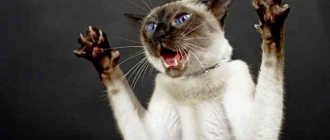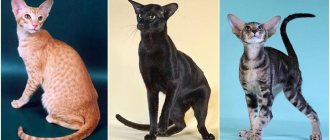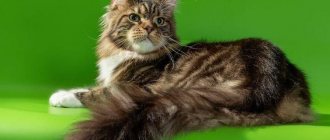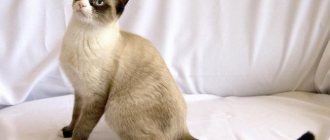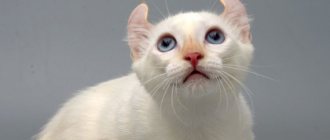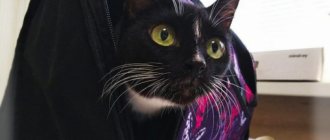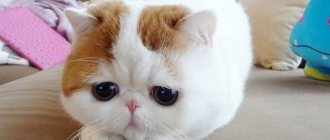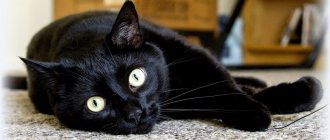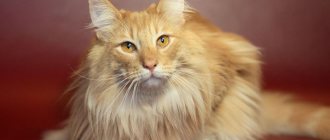For most ordinary people, a cat is a four-legged meowing creature that lives next to a person. Basically, they differ only in appearance: color, type of muzzle or long hair.
The variety of cat breeds is multifaceted, among them there is a breed of cats with short legs, with long or completely lost hair (see what is the name of a cat breed with short legs). But there is a very unique breed with a tail that is in its infancy, or completely missing.
It is not stopped at birth like in dogs, but is a distinctive elite feature. Many clients are willing to pay big money for this originality.
How to find out a cat's breed by coat color
Very often it is possible to distinguish a purebred aristocratic cat from a simple Murka by color.
Domestic cats are usually very plainly colored, two or three colors, and have large spots or stripes. Experts have worked thoroughly on the colors of purebred animals. Sometimes you can immediately determine the specific breed of a kitten using this feature.
Siamese
The striking Siamese color, the so-called color point, is characterized by darker areas on the cat's face, ears, paws and tail.
Initially, only Thai or Siamese cats could boast of this, but over time, breeders gave this coloring to many breeds:
- Balinese;
- British;
- Neva Masquerade;
- Himalayan;
- Burmese;
- Persian;
- ragdoll, etc.
A cat with a Siamese color is a Balinese Himalayan cat with a Siamese color
There are several varieties of point colors in cats, depending on the contrast of colors and the smoothness of the transition from dark to light:
- seal point - soft cream;
- blue point - silver-blue;
- chocolate point - brown-chocolate;
- lilac point - pinkish-bluish;
- red point - pronounced apricot (red);
- cream point - delicate beige-amber;
- caramel point - grayish-beige;
- cinnamon point - red-brown;
- fawn point - pale cream.
Chocolate point cat
Only a specialist felinologist can competently determine all the nuances of point colors. A kitten is always born white. The marks (points) begin to darken after a few days.
Blue
Solid blue color, also known as grey, is traditionally considered an integral feature of British breed cats. It can be detected immediately even in a newborn kitten. But in fact, all shades of grayish blue are also found in many other purebred representatives of the cat world, such as:
- chartreuse;
- Maine Coon;
- Russian blue;
- Scottish;
- oriental;
- Nibelung;
- korat etc.
Breed: Russian Blue cat
Sand
If the kitten has a rare sand or red color (sorrel), then this allows us to determine whether it corresponds to one of the breeds:
- Somali;
- Abyssinian
A cat with a sorrel coat color is an Abyssinian breed
Wild
Natural animal colors, making cats smaller copies of tigers and leopards, are called wild (tabby) and are found in the following breeds:
- savannah;
- ocicat;
- Serengeti;
- Bengali;
- Egyptian Mau;
- caraquet;
- Kanaani;
- Kurilian bobtail;
- safari, etc.
Kurilian Bobtail - wild-colored cat
Most often, wild colors are characteristic of hybrid breeds. You can instantly determine who belongs to them.
Brown
The uniform and monochromatic brown color of a kitten's fur coat will immediately determine its royal origin and worthy position in the cat elite. This color is practically never found in the wild.
Cats of the following breeds come in similar colors:
- British;
- oriental (havana brown);
- Burmese;
- Scottish;
- Abyssinian;
- Persian;
- Chantilly-Tiffany, etc.
Burmese - a cat with a brown color
Description, what it looks like, what colors there are
The appearance and bright colors of the Bobtail immediately attracts attention. These cats have well-developed muscles, stockiness and a strong build. Sexual dimorphism in representatives of the breed is pronounced - cats are much larger than cats
The fact that Kurils have wild roots is clearly visible in their appearance, both in long-haired and short-haired varieties.
Sexual dimorphism in representatives of the breed is pronounced - cats are much larger than cats. The fact that Kurils have wild roots is clearly visible in their appearance, both in long-haired and short-haired varieties.
Black
The color can be either completely black or with a small splash of white hair on the chest and ends of the paws. In old age, Kurils with this color may develop a brown tint.
Black and white color
Black marble
This color is inherited from the wild ancestors of Bobtails and gives the cat a particularly impressive appearance. This color belongs to the tabby color and is most often found among Kurbobs.
Black and white
Black and white is quite varied. It can be a basic black color interspersed with white, randomly located. Another option is a white base interspersed with black. Black and white striped color is very rare.
White
Solid color, in which a blue iris is allowed. The long-haired representatives of the breed look especially impressive.
Ginger
Available in solid or tabby color. The category of redheads includes red and cream colors. The presence of white inclusions is allowed.
Grey
Solid and tabby colors are possible. The presence of inclusions of white wool is allowed. Blue colors also fall into this category.
Tortoiseshell
Kurbobs have tortoiseshell colors according to the standard, only black and blue are possible. In black suit with this type of color there are inclusions of brown, red and white wool, with a predominance of dark tones. The blue color combines light and dark wool of a silver-gray, bluish color. This option is less common and looks especially impressive.
Origin of tailless cat breeds
Cats appeared on Earth much earlier than humans. Therefore, it is impossible to take into account the participation of primitive people in their selection. Nature has independently worked on the diversity of species, and the survival of representatives of the cat family proves their adaptability to any evolutionary surprises.
The first version is based on rationality - mother cats simply bit off the tail of their newborn offspring. Thus, they deprived the babies of an unprotected part of the body, which an enemy could grab in a fight.
There is also an opinion that numerous offspring did not fit in a cramped den and became easy prey for predators who pulled the kittens out of the shelter by their long tails.
The next hypothesis is the origin of cat breeds without a tail from lynxes. They belong to the same family - in the appearance and habits of the first and second there are so many common features that the thought of a close relationship involuntarily arises.
The third version began to be considered with the development of genetics. An uncontrolled natural mutation is suspected due to the original limited geographic range in which tailless cats lived. Early reports of them include:
- to island territories;
- to distant countries that led a closed lifestyle.
Under such conditions, inbreeding, arbitrary gene mutations and the consolidation of the characteristic characteristics of the breed occurred. Their genes dominated in subsequent selection relationships with indigenous breeds of other territories.
According to their characteristic features, all cats without a tail are divided by international felinological associations into 3 groups:
- Rumpy - the animal has no tail.
- Riser – very small, visible only in short-haired cats. Hidden in long-haired or semi-long-haired breeds.
- Stumpy - arbitrary length, but shorter than regular cats.
The inherited instructions of the tailless mutation are not universal and are not determined by any one property in all cats. Researchers suggest a complex involvement of dominant genes and polygenes that influence the overall characteristics of animals.
How to get beautiful offspring
People who breed cats with short tails are very fond of this breed. For females that have a tail of eight to two centimeters, short-tailed males are selected. This may result in bobtail offspring.
The first mating can be carried out when the cat is one and a half years old, provided that estrus has already appeared. To do this, two periods of the onset of estrus are skipped and only then the female can be mated.
The main differences between purebred pets and domestic ones
A purebred cat always has one or more distinctive characteristics that allow it to be classified as a particular breed. This could be an interesting color, unusual ear structure, iris color, etc.
These qualities are fixed by the standard, so representatives of the same breed are quite similar to each other. But the differences between cats of different breeds can be dramatic.
Non-pedigree cats differ much less from each other in appearance. They can be identified by the following unifying characteristics:
- medium-sized, high-set triangular ears sticking straight up;
- regular shaped round head;
- elongated, graceful body of correct proportions;
- muscular, long paws with soft pads and sharp claws;
- well-set round eyes;
- an energetic and agile long tail that well expresses all the cat’s emotions.
Famous, popular breeds of hairless cats and cats: photos, description of character
Hairless cats are owned by exotic lovers and people suffering from allergies to wool. Due to the lack of a fur coat, such animals often freeze, so they can only live in warm apartments. These breeds are not suitable for people who are rarely at home, as they absolutely cannot tolerate loneliness and require constant attention.
Hairless cat breeds are believed to be endowed with extremely high intelligence. Hairless cats are different and do not look alike.
The Canadian Sphynx is a fairly heavy, medium-sized cat with very short hair that feels like suede.
The nature:
- very active and playful
- quickly gets used to people and habitat
- follows the owner's heels and, on occasion, always strives to jump onto his lap
- not vindictive
The Canadian Sphynx
Peterbald (Petersburg Sphynx) is a breed that emerged from crossing an Oriental cat with a Don Sphynx. These animals have an elegant, even sophisticated appearance.
They have an easy-going and easy-going disposition:
- smart and sociable
- affectionate with all family members
- playful
- very attached to the person
- gets along easily with everyone
- not conflicting
The Peterbald
Ukrainian Levkoy is a fold-eared, hairless cat, not a universally recognized young breed. Has an unusual appearance and wonderful character:
- extremely loving and affectionate
- loyal to the owner
- easily adapt to new things
- not capricious and not picky
- have high intelligence
- afraid of heights
The Ukrainian Levkoy
Donskoy Sphynx is a relatively young breed bred in Russia.
Characteristics:
- completely devoid of aggression
- extremely friendly and cheerful
- very active, therefore capable of mischief
- sensitive, feel the owner perfectly
- calmly tolerate hygiene procedures
- easy to learn
- love attention
Don Sphynx
Bambino are funny little animals, the result of crossing Munchkins and Canadian Sphynxes. They look like funny kittens, just as cute and touching.
These cats took the best from both breeds:
- sociability and curiosity
- cheerful disposition
- devotion to masters
- affection and tenderness
- high intelligence
- love of walking and traveling
- getting along with other pets
The Bambino
Cornish Rex is not a completely hairless breed. Unlike other representatives of the rex, they only have undercoat as hair. They have astrakhan fur due to the absence of guard hairs. Slender and graceful cats.
Peculiarities:
- Can't stand drafts
- love to eat
- loyal to the owner, and even wag their tail like dogs
- smart and quick-witted
- active and very playful
- sociable and curious
Cornish Rex
Dragon Li
At first glance, this breed is no different from ordinary domestic cats, but the distinctive feature of the Li Mao breed is green or yellow slightly slanted almond-shaped eyes, and small black dots (in the form of a smile) at the edges of the mouth. And also a strong, muscular body, proportional paws of equal length, an elongated head with a rounded forehead, rounded ears and, of course, a long tail. Brown tabby is the only color recognized for this breed.
Dragons are smart cats with a calm character. Because of this, they are easy to train and learn. They get along easily with other pets, but have a hard time getting used to children (although they treat them with due tolerance). Li dragons do not require special care and do not have hereditary diseases.
Unique Pixie Bob
Short-tailed cats have in their brethren the rare breed of pixie-bob cats. Outwardly, there is a similarity with a lynx: a muscular body on flexible legs, squat, tassels on the ears, a hare-type tail, striped color.
The breed arose by human decision: special directed crossbreeding in 1980. Their distinctive feature is the tail - both short and medium length (2.5-15 cm). A purebred has a tail without kinks, but they can be present in hybrids. Cats have a certain tolerance - 7 pads on their paws (polydactyly).
Dream Interpretation - Cat as a symbol
According to Indian myths, a cat is an animal that belongs to the great goddess, the guardian of all newborns. This goddess is usually depicted riding a cat, which is why in India she is revered as a sacred animal. According to the beliefs of the ancient Germans, a person who loves cats will be happy in marriage, while one who has an aversion to cats will marry a grumpy and angry woman. In any case, he will not have children. In all fairy tales, myths and legends, cats accompany witches, goddesses and fairies. The cat represents femininity, softness and charm. However, later (in the Middle Ages) this animal began to be considered a companion of witches, so cats were persecuted. In dreams, a cat symbolizes feminine attractiveness, magnetism and sensuality. In Indian mythology and fairy tales of different peoples of the world, the forest is the habitat of the creator god. However, there is another interpretation. In Vaishnavism and Krishnaism, the world is a “forest of eternal joys,” a place of mystical experience. Symbols have a similar interpretation in dreams. Look in any dream book - the forest has many meanings, but we are interested in a different interpretation. There are many dangers in the forest, but those who go through it to the end can experience sensual joys, love and desire.
Read with this
Manx cat
At first glance, these cats may give the impression of something spherical, which is confirmed by the absence of a tail. But despite the lack of a tail, these pets are endowed with character and personality. Such cats are smart, patient, and will not have problems adapting to new conditions. As a rule, they give themselves completely to their owner, but they also get along well with other family members. And not only with people, but also with animals.
These cats are characterized by long hair. As for color, it can be very diverse. On average, the weight of an adult cat is up to 5 kg, cats weigh about 3-4 kg. It is noteworthy that Manx cats love water. If you turn on the water in the sink or bathtub, don't be surprised when you see your pet under the running water. But this does not mean that Manx cats love to swim. A cat can sit in the rain for a long time, but you have to try hard to get the animal into the bathroom.
Diseases
The immunity of cats of this breed is enviable. But they also have weaknesses.
The first thing you should pay attention to is the ponytail, or more precisely, the area under it. At the very first inspection, find out whether there are any cracks, irritation or ulcers.
Such a short length is a prerequisite for the occurrence of an inflammatory process or prolapse of the anus. The Kurilian Bobtail should be examined regularly, and if damage is found, take it to a veterinarian for examination. Remember: if you feed your cat poorly, he will develop this kind of illness quickly.
Ordinary sea buckthorn oil helps to deal with small cracks: they lubricate the anus area with it and make sure that the cat does not lick it right away.
The second nuance: in Kuril Bobtails, the urine pH is significantly different from the urine of cats of other breeds (7-7.5 versus the usual 6-6.5). Therefore, they rarely suffer from urolithiasis of the alkaline type.
Timely and regular vaccination will help protect your pet from a number of diseases - rabies, rhinotracheitis, panleukopenia, calicivirus, leukemia, peritonitis. The kitten receives its first vaccinations at the nursery, but in the future you will have to learn the vaccination calendar and take your pet to the doctor yourself.
Information about the procedures is entered into the veterinary passport. You should not vaccinate yourself (if you do not have the appropriate education: a mistake can lead to serious consequences. Do not try to vaccinate your pet against all diseases at once: this is too much stress on the immune system!
How to choose the right kitten
Manx cats are rare breeds, and now there are no nurseries in Russia that breed them, but the prices for kittens are not very high. In the USA, a kitten with a tail costs $100, and tailless representatives of the breed cost from $200 to $400. Show class babies cost up to 1500 green. In England or Australia, kittens are a little cheaper.
The most important thing when purchasing a baby is to find a nursery with a good reputation abroad. At the same time, remember that many nurseries do not sell kittens to foreign clients and do not agree to send their pets on planes without accompanying persons. You will either have to hire someone to fly with the kitten, or go with it yourself.
If you want to adopt a kitten for exhibitions, seek the help of a specialist. Although it also happens that the winners are mediocre cats that have been castrated.
It is important to pay special attention to the tail or lack thereof. Sometimes breeders specially dock the tails of kittens, passing them off as representatives of the Manx breed.
The most famous representative is the Bobtail
“Bobtail” translated from English means “short tail.” The general name of the breed combines several different types of cats from around the world. Each subspecies has its own habits, character and body structure.
American Bobtail
The father of this breed was the cat Yodi, who lived on a South American Indian reservation. In 1970, a standard for this breed was adopted, and the American Bobtail gained worldwide recognition only in the early 90s. These cats are very similar to lynxes, and they can come in a wide variety of colors. There are elegant tassels at the tips of the ears, a dense build, a slightly elongated body and massive paws.
They have a playful character and can be affectionate. Smart and easy to train animals. Freedom-loving. They need extra care for their long and thick coat. Problems may arise during reproduction.
Japanese Bobtail
This cat breed has been known in Japan for hundreds of years. How and under what circumstances the breed was formed is unknown. In their homeland, these cats bear the proud name Mi-ke.
How to properly care for a Sphynx
Medium size breed. The tail is 5-7 cm long and has a special structure in each individual. Unusual triangular head with narrow eyes and a long nose. Medium length coat without undercoat. Tricolor color: black, red and white.
They are characterized as intelligent and friendly cats. They love to swim. Suitable for keeping in an apartment. Easy to learn.
Kurilian Bobtail
A relatively young breed of cats, bred in Russia. It was first presented at the exhibition in the 80s of the 20th century.
The tail length is no more than 15 cm. The tail structure of each individual is unique. The animals are large, strongly built with powerful paws (the front ones are shorter than the back ones).
The character of these cats is often compared to that of a dog. Freedom-loving, but very loyal animals. They don't mark the territory, they don't smell like cats. They love to fish and hunt. Not fully domesticated.
Karelian Bobtail
The breed was formed as a result of natural mutations. The habitat of aboriginal cats is the coast of Lake Ladoga. In selection from phylinologists since 1992.
Tail length is 4-12 cm. There are a wide variety of colors. The cat is medium-sized, strong-built with well-developed muscles. The front legs are much shorter than the hind legs. The coat can be either long or short.
Karelian Bobtails become very attached to their owner. Very affectionate and friendly. Unpretentious in care. They rarely get sick.
Mekong Bobtail (Royal Bobtail)
It was born as a “by-product” of the breeding of Siamese cats. The Russian breeder, having received several short-tailed kittens, continued his work. As a result, a new breed of bobtail.
10 Dumbest Cat Breeds
A distinctive feature is the Siamese color. The structure of the tail is unique for each individual. Short dense body. The hind legs are longer than the front legs. Wedge-shaped head. Short coat with undercoat. Eye color is blue.
They are described by breeders as intelligent and sociable cats. They often live up to 20 years. The coat requires additional care.
Toy bob
The progenitor of Toy beans is considered to be a Russian cat named Kutsy, born with a mutation in Rostov-on-Don in 1988. The breed was registered as experimental by American breeders in 2009. The second name is Skif-toy-don.
A miniature cat with a strong build and well-developed muscles. Tail length 3-7 cm. Dense coat. There are both short-haired and semi-long-haired animals.
These cats have dog-like habits. Easy to learn commands. Trusting and fearless. Males of this species do not mark territory and have no characteristic odor.
Pixie bob
"Pixie Bob" translates from English as "Elf with a short tail." The breed was obtained through long and painstaking selection by American breeders. Registered in 1995.
Very similar to a lynx. A special feature is polydactyl paws. The body of the animal is medium in size. Males are 2 times larger than cats (females 3-5 kg, males 5-10 kg).
These cats have few kittens in their litter (maximum 3). They are characterized by breeders as unobtrusive in communication with the owner and wary with strangers. It is extremely rare to release their claws. Not aggressive. Unpretentious in care.
7 Cat Breeds with Amazing Chocolate Colors
Caring for bobtail cats
The Bobtail is a cat that does not require any special care. The semi-longhaired coat does not tangle, so brushing once a week is sufficient. Short-haired dogs are even less often - 2 times a week. Animals take good care of themselves. They only need bathing if they are very dirty. Moreover, they treat water calmly, and Kuril and Karelian bobtails love water.
The main rule in feeding is a balanced diet. This is not easy to achieve with a natural diet. Therefore, breeders recommend feeding cats with high-quality super-premium food.
Bobtails are easily trained to walk on a leash. If it is not possible to simply let the cat go outside, then the pet will only be happy with such walks.
Health
This breed boasts strong and good health. They have virtually no predisposition to genetic diseases. The occurrence of such diseases is possible only if the crossing of parents was carried out incorrectly. For example, one of them is a representative of a hybrid breed.
In other cases, health problems may arise due to improper care and feeding of the animal. If the amount of carbohydrate food in the diet exceeds the norm, there is a risk that the cat will suffer from obesity and diabetes. Neglecting to brush your teeth can lead to periodontitis.
Advantages and disadvantages of bobtails
Advantages of bobtails:
- attractive exterior;
- playfulness;
- lack of aggression;
- balanced character;
- high intelligence;
- no problems with upbringing;
- cleanliness;
- pickiness in food and care.
Flaws:
- tendency towards obesity among “Americans”;
- desire to take a dominant position (Japanese);
- unfriendly attitude towards strangers (Japanese);
- hyper-reactivity;
- early sexual maturity in the Mekong.
Short tail
It is noteworthy that the presence of a tail in a “rudimentary” state or its complete absence in cats is a sign of “noble” origin (in contrast to the same domestic dogs, whose tails are docked deliberately - to fit the animals to the standards of a particular breed). It is worth noting that there are only a few types of short-tailed/“tailless” cat breeds, which include:
Kurilian Bobtail
a short curved tail approximately 5-9 cm long, resembling a fluffy pom-pom and characterized by mobility, a relatively small body with strong bones, developed muscles and limbs of medium length, a triangle-shaped head with medium-sized eyes corresponding to the color, short-haired or semi-long-haired, but in in any case, with a fluffy collar on the neck and chest.
more details
American Bobtail
a short and flexible tail from 2.5 to 8 cm long (it can be straight, curved, and slightly curled at the end), a body of medium length with an athletic build and strong paws proportional to it, a round muzzle with strong jaws and ears, an internal the surface of which is covered with long fluffy hairs, short or long hair, but always thick and slightly harsh.
more details
Japanese Bobtail
a short tail no more than 12 cm long (straight, curled, curved or in the form of a pompom), a long and lean body with a flat back and slender legs (the hind legs are noticeably longer than the front ones), a muzzle with large oval-shaped eyes and large, wide-set ears, soft and silky coat of medium length.
more details
Mekong Bobtail
a short and broken tail with a length of at least three vertebrae (but no more than a quarter of the length of the body itself), a strong and muscular body of medium size with long legs, a wedge-shaped head with medium-sized ears (with rounded tips) and slightly slanted eyes, always bright blue , short silky coat with minimal undercoat.
Karelian Bobtail
a short tail 4-13 cm long (can be either kinked or almost straight), a strong body with an even posture and proportional paws, a narrow head with a small strong chin and rather large ears with tiny “tassels”, short or long hair ( necessarily dense).
Kurilian Bobtail
“no, not a relative”
short tail 3-8 cm long (with pronounced kinks), strong build with a slightly arched back and powerful paws, large trapezoidal head with a powerful chin and proportional ears, short or long hair (very soft to the touch).
more details
Pixiebob
short straight (but possible kinks) tail about 5 cm long, large and muscular body build with powerful bones and a clearly defined arch on the back, large pear-shaped head, tightly knit and strong paws (the hind legs are noticeably longer than the front ones), short or moderately long hair with different color options, but always with small or medium spots throughout the body.
more details
Manx cat
they may either have no tail completely, or have a small “stump” hidden under the fur, or generally have a tail of normal length, a medium-sized round body with a round head, powerful limbs with well-developed muscles (the front ones are noticeably shorter than the back ones), round eyes with a slight slant, short and thick coat, like “plush”.
more details
Cymric cat
Kymrik
tailless breed (but there can be either a “stump” or even a full tail), a tightly built physique with a wide chest and an arched back, short front and long hind limbs (with heavy shins), thick hair of medium length.
more details
Famous, popular breeds of fold cats and male cats: photos, description of character
Funny animals with unusually shaped ears are loved by many. The number of fold-eared breeds is very small, since by their nature cats are hunters who need protruding ears for good orientation.
Scottish Fold (Scottish Fold) is a plush cat, similar in appearance to the British breed. A distinctive feature is the ability to sit “on the butt”.
The character is also very reminiscent of the British:
- friendly
- inquisitive
- calm
- easy to train
- feel the mood of the owner
- are not afraid of strangers
- kittens quickly get used to the litter box
- not aggressive
- incapable of revenge
- sensitive, cannot stand shouting and rude treatment addressed to them
- travel easily
- don't like to jump
- do not scream loudly, make only quiet sounds
Scottish Fold
Highland Fold is a Scottish fold long-haired cat. The animal is medium in size with silky long hair.
Like all Scots, they are different:
- calm and balanced disposition
- playfulness that does not go away with age
- curiosity
- good adaptation, not afraid of moving
- love to be around people
Highland Fold
The Ukrainian Levkoy , mentioned above, also belongs to the fold-eared cat breed
Cat breed with short tail
As you know, there is no arguing about tastes - some people like cats with a fluffy long tail, while others admire a short-tailed kitten. There are several cat breeds that have a short tail, and there are also cats without a tail at all.
The common name for short-tailed cat breeds is bobtail, from the English “bobtail,” which means “cut tail.” Bobtail can be short-haired (Japanese, Thai) and with hair of different lengths (American, Kuril, Karelian).
The oldest of these breeds is the Japanese Bobtail. This small graceful cat comes from the Land of the Rising Sun. Representatives of this cat breed are bicolor or tricolor, most often with red and black spots on a white background.
Japanese and Thai bobtails differ in color. The Thai (Mekong) Bobtail has a characteristic Siamese color and blue eyes. This graceful cat has a short tail with kinks and hooks, which is considered a characteristic of the breed.
The American Bobtail is a stocky, rather large cat with a pom-pom tail. A pet of this breed can be short-haired or long-haired, any color is allowed.
The Kurilian Bobtail is a cat breed that was formed without the participation of breeders. This is a large animal, its weight can reach 7-9 kg. The coat is allowed to be short or long, the color is arbitrary.
The Karelian Bobtail can also be long-haired or short-haired, any coat color is recognized. These varieties differ from each other in size (the Karelian bobtail is more graceful and smaller than the Kurilian).
In addition to the bobtail, there is a rarer breed of cat with a short tail - the pixie bob.
This is an unusual short-tailed cat that resembles a lynx. Pixie bob is quite large, its weight reaches 10 kg. These cats have a “bunny” tail and tufted ears, and their paws can have 5-7 toes. Pixie bobs are short-haired or semi-long-haired, and the color is tabby (striped).
In addition to cats with short tails, there are completely tailless cat breeds, Manx and Cymric.
Manx (Manx tailless cat) got its name from the Isle of Man in the Irish Sea. A distinctive feature of this cat, in addition to the absence of a tail, is its “jumping” gait (like that of a rabbit), since its front legs are shorter than its hind legs. She has thick, short, plush fur, and any color is allowed.
Cymrik is an adorable long-haired, tailless cat that resembles a bear cub. This is a cross between a Manx and a Norwegian forest cat.
Short-tailed cats not only have a memorable appearance, but also an outstanding character. Many of them resemble dogs - they are able to follow commands, are very devoted to their owners and follow on their heels.
Feeding
When choosing food for the American Bobtail, it is important to consider that the digestive system of representatives of this breed is very sensitive, including to changes in diet. It is better to immediately decide on the type of nutrition and then stick to it. At first, it is advisable to feed the kitten what he ate at the breeder’s house, gradually switching to food that is convenient for the owner
At first, it is advisable to feed the kitten what he ate at the breeder’s house, gradually switching to food that is convenient for the owner
It is better to immediately decide on the type of nutrition and then stick to it. At first, it is advisable to feed the kitten what it ate at the breeder’s house, gradually transitioning to food that is convenient for the owner.
Yankee beans are suitable for both industrial feed and well-balanced natural nutrition.
The first option is preferable for people who do not have the time or special knowledge to create their own diet. You need to choose food of a class no lower than super-premium class. Products from supermarkets can cause serious harm to your pet's health. Breeders recommend purchasing products from the following brands for Snow Beans:
- Carnilove;
- Vigor&Sage;
- Acana;
- AATU;
- Applaws;
- Now Natural Holistic.
Owners who decide to prepare food for their cat at home must remember that food from the human table is not suitable. It contains a lot of salt, sugar, fats. The basis of the diet (approximately 80%) should be lean meat. Suitable protein for Bobtail:
- beef;
- chicken;
- turkey;
- rabbit meat;
- offal (heart, lungs). It is permissible to add liver no more than once a week.
To the proteins you should add a little mixture of:
- buckwheat;
- carrots;
- rice;
- any type of cabbage, except white cabbage;
- pumpkins;
- fresh herbs;
- zucchini;
- green beans.
The ingredients can be combined in different combinations. Boil cereals, it is permissible to give vegetables raw, in crushed form. Meat should be frozen beforehand to protect your pet from helminthic infestation.
Once a week, you are allowed to give your cat boiled sea fish, thoroughly pitted, and a raw or boiled egg (chicken, quail). One feeding can be replaced with kefir, fermented baked milk, natural yogurt with the addition of cottage cheese and bran.
It is forbidden to feed Bobtail:
- whole milk;
- pork;
- bread, baked goods;
- onions;
- sweets;
- lamb;
- legumes;
- potatoes;
- river fish;
- bones;
- mushrooms;
- garlic;
- semi-finished products;
- nightshades (tomatoes, eggplants);
- sausages;
- fruits;
- canned meat and fish produced for people.
Kittens aged 2 to 5 months should be fed 3-4 times a day. After six months, the pet can be switched to two meals a day.
When feeding a cat naturally, it is often necessary to add vitamin and mineral complexes to its food. The following drugs are suitable for Yankee beans:
- VetExpert VetAminex;
- AniVital FeliDerm;
- Petvital Energy (Canina);
- Nutri-Vet Probiotics Salmon Oil;
- 8 in 1 Excel Brewer's Yeast;
- Beaphar Laveta Super.
Warning! The names of dietary supplements are given for informational purposes; it is permissible to give them to a cat only after consultation with a veterinarian.
For the sensitive digestion of the obese American, it is advisable that he receives food at approximately the same time. For owners who spend the whole day at work, it is better to purchase an automatic feeder with a timer for supplying a given amount of feed. This will prevent your cat from overeating or starving. For animals with poor appetite, you can purchase a device in the form of a labyrinth toy, from which food must be obtained. It will be additional entertainment for the Bobtail and will help him realize his hunting instincts.
It is important that your pet has constant access to clean water. Many owners are faced with the refusal of furry predators to drink. In this case, automatic drinking fountains in the form of fountains help to correct the situation.
They imitate a natural body of water, the movement of the liquid attracts the cat, he drinks with pleasure
In this case, automatic drinking fountains in the form of fountains help to correct the situation. They imitate a natural body of water, the movement of the liquid attracts the cat, and he drinks with pleasure.
An active, playful breed
Reproduction and lifespan
Manx cats become adults quite late, at the age of 1.5 years. When mating cats, the rule is followed: one partner is tailless, the other with a normal tail. Usually 2-3 kittens are born; tails in newborns may be absent, shortened or long.
Manx cats get along well with dogs and small children.
In the old days, breeders would dock kittens' tails if their length did not meet expectations. Most associations of felinologists have banned this operation so as not to violate the natural design and not to mislead future owners. Manx syndrome may appear in the first months of life. Sick kittens die or are subject to culling.
The genetic complexities associated with taillessness suggest that Manx breeding is carried out by experienced breeders with mandatory veterinary supervision. Healthy kittens grow quickly, get sick little and begin to age at 14-15 years. There are long-livers who remain playful at the age of 18.
Let's get acquainted - Menx
What do we know about the Menskaya cat breed? These cute pets came to us from Ireland. As you may have guessed, their homeland is the Isle of Man. What caused the appearance of an animal without a tail is not known for certain; there are many conflicting legends and rumors, but they can serve as proof of the rich imagination of local residents and nothing more. Most likely, the absence of a tail is a gene mutation as a result of numerous incests on a limited island territory.
Menx is a very cute creature. Representatives of this cat breed do not need outdoor adventures. They love their home and all its inhabitants. Their friends can be dogs, hamsters, parrots - any animals living in the same apartment with them.
Men's cats love water. They enjoy jumping into the bath or watching the tap open.
Menx grow quickly, but mature slowly; this feature of the breed makes them cheerful and playful much longer than others.
What else do we know about tailless Menx?
Representatives of the tailless breed of Menx cats have their own classification:
- Rampi is a completely tailless cat;
- rumpy riser (rised), riser - a cat whose tail looks like a small stump, since it retains part of the cartilage at the base of the tail;
- Stumpy is a type of cat whose tail is much shorter than the standard length, it consists of two to three vertebrae;
- longi or taili - a cat with a tail of normal length.
All these varieties can appear within the same litter.
Purchasing a kitten
If your goal is to participate in exhibitions and breed Siamese cats, choose your pet carefully. The future winner must be of high blood, from titled parents and reliable breeders. The owners of a mother cat or cattery are required to issue a certificate indicating the date of birth of the kitten, the names of its and its parents, breed and color. Later this document is exchanged for a pedigree. The price of Siamese kittens, which will become participants in exhibitions and producers, reaches 800 euros and more. The more titles parents have, the more expensive their offspring will be.
The future champion must have high-born ancestors
If you need a cat for the soul and games, the costs will be much more modest and the choice will be easier to make. You can buy a kitten from a breeder or in a nursery, then it will definitely have all the characteristics of the breed. But you have the right not to be given documents if the animal will not be exhibited. The price of a small Siamese in this case will be 10–15 thousand rubles, and sometimes less.
There are nurseries in Russia where they seriously study Siamese and other oriental breeds. A list of some and their coordinates can be found here.
Criterias of choice
The potential winner and prize-winner of cat shows is meticulously chosen
It is important to exclude any grounds for disqualification. Already at a young age it is clear what the baby will become
By this time, dark markings should appear, whether the tail is straight, the number of fingers, what color of the eyes - everything is visible. When choosing a kitten, check the criteria for compliance with breed standards. And, of course, the future pet should evoke sympathy from the owner. It is difficult to raise a champion without mutual love.
When purchasing a kitten, you need to understand what your goals are.
A kitten that is bought for pleasure does not need to be subjected to strict inspection. The main selection criteria will be character and health. Do not choose a pet at the market, only at home. There you will see how a cat is kept, take a good look at the babies and their mother
Pay attention to the condition of the kitten's fur, eyes, and ears. If something worries you, refuse to purchase
The Siamese cat was our first pet. In the apartment of the mother cat's owners, we saw kittens hanging in a bunch right on the wall (thick vinyl wallpaper was in fashion at that time). It seemed funny. But a day later the little Siamese began to hang on our wallpaper. And we had no time for fun. It took a long time to wean her off the bad habit.
Age of kitten for moving to a new family
Experts do not recommend purchasing a kitten younger than 2.5, or preferably 3 months. Kids react painfully to parting with their mother and moving. Usually by 3 months they get used to independence, know how to eat and are toilet trained. Check with the cat's owners what they fed the kittens, and at first stick to the same diet. By this age, little Siamese should already have received mandatory vaccinations and deworming.
Disqualifying faults
A number of defects lead to disqualification from breeding. They are not very common and significantly reduce the cost of the kitten, since in this case it is not valuable for breeding. Kurils with the following defects are subject to culling:
- tail length that exceeds 13 cm;
- complete absence of a tail;
- deafness;
- undescended testicles or one testicle;
- a very short tail that has no bends or kinks;
- erosion of the mucous membrane in the anus;
- spinal deformity;
- amputated claws.
Non-disqualifying defects include the following:
- insufficient length of the front legs;
- excessively bulging or too deep-set eyes;
- excessive arching of the back;
- extra vertebrae in the tail;
- cheekbones too high;
- narrowed head;
- undeveloped undercoat;
- sharp tips of the ears;
- disproportionately long body.
With minor defects, cats are allowed for breeding, but most often to produce non-elite offspring, which will have an average price. Such individuals do not occupy high places at exhibitions.
Origin story
Before delving into all the characteristics of the original tailless cats, it is worth learning about the history of their origin.
Stories related to the appearance of cats without tails are shrouded in a huge number of different legends, fairy tales and speculations. For example, there is a belief that one day a cat was late for boarding the animals into Noah’s Ark, and her tail was pinched by the door. In Thailand, there is another interesting legend that says that there were Thai beauties who used short cat tails to preserve jewelry.
There are other unusual and fabulous stories about the appearance of tailless mustachioed pets.
All varieties of tailless cats can be divided into two main subgroups:
- Manx;
- bobtails.
All other existing varieties of these animals arose precisely on the basis of these groups. Most likely, these lines developed parallel to each other or could have been introduced in a certain time period from one area to another. At present, it is impossible to establish this fact precisely.
Bobtails have their origins in Japan. These individuals first arrived there on merchant ships in 530-540 BC. If you believe the legends, in those days they still had tails. However, fear of the evil forces contained in the forked tail of the divine cat Nekomata, which brought illness and death to people, led to the fact that they soon began to be chopped off.
Animals that did not have tails began to be called maneki-neko. It was believed that such pets bring wealth, luck and happiness to their owner. Such actions in relation to tails over many years eventually led to a special gene mutation, and kittens began to be born with a very short pom-pom tail. The Japanese were incredibly happy about this phenomenon. They believed that using this method they were able to defeat the evil god with the help of their pet mascots.
There is an opinion that cats instinctively chewed off the tails of their kittens to protect them from unpleasant consequences. Another version says that the mutation occurred on its own, without external human influence. The Japanese only consolidated it using selection methods.
As for the Manx breed, it was born on the Isle of Man, which is located next to Great Britain. It was from there that representatives of this subspecies were distributed throughout the countries of Europe and America. It is believed that the ancestors of these animals are British shorthair cats, in which the “tailless” mutation was preserved by selection.
The first mention of cats without tails was made in 1750. Due to their compact size and isolation, such animals interbred with each other. Due to such actions, other representatives of the breed with very short tails began to be born in the future. From the very beginning, all these animals had short hair, while long hair was considered a deviation from the norm. However, over time, longhaired Manx cats began to be bred in Canada as representatives of a separate breed.
Choosing a purebred pet
Getting a cat without documents is not difficult. You can take a suitable pet:
- at a homeless animal shelter;
- in the nursery (unscheduled mating or presence of defects in the animal);
- by advertisement in various media (print publications, Internet resources, etc.);
- at the market, near the metro, at a transport stop;
- in a pet store;
- from neighbors, friends, etc.
Outbred kittens can be bought for pennies on the market
When choosing a kitten, you need to consider the following points:
- Baby's activity and mobility. He should run to get acquainted with curiosity, and not cower in a corner in fear.
- Healthy appearance. There should be no discharge from the eyes, ears or nose. The anus is pink and clean.
- Condition of the oral cavity. The teeth are clean, without tartar deposits. Gums are shiny. Pink and don't bleed.
- Wool cover. The fur is shiny and even, without bald spots or tangles.
- The abdomen is firm but soft.
- No defects (third eyelid, extra fingers, tail creases, etc.).
The kitten should look healthy
Pros and cons of Siberian cats
Before deciding whether to get a cat of this breed, you need to carefully weigh its advantages and disadvantages in comparison with others.
To make this easier, we will give an approximate list of both - of course, for some one will turn out to be very important and the other quite insignificant, for someone the features that are not reflected at all below will seem important - but you can get a rough idea.
Pros:
- Friendly and energetic – the Siberian cat loves to play with people; when she is in a good mood, she is calm about being squeezed;
- Intelligence - it is quite easy to teach her the rules of behavior in the house, and she can even remember several commands;
- Beauty - they are fluffy and very beautiful, it’s not for nothing that in the West there are queues for every kitten;
- Health – they get sick quite rarely, especially if they are well maintained, and can live up to 15-20 years;
- Unobtrusiveness - if a Siberian cat sees that the owner has no time for her, she will not hang around, but will go about her business;
- The ability is almost everything that people have.
Minuses:
- The need for hair care. It will need to be combed regularly and thoroughly, otherwise hair will fly around the apartment, and the pet itself will lose a significant part of its external gloss;
- Need for walks - in a private home, a cat will often walk for most of the day, which can sometimes lead to torn ears and other injuries. In the apartment, she must be taken out for a walk at least for a couple of hours;
- Aggression towards other pets - such a cat will most likely not give life to rodents and other small pets. It can easily not get along with large dogs and other cats.


